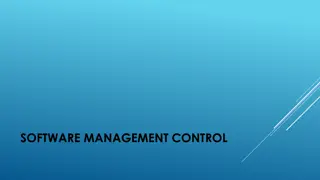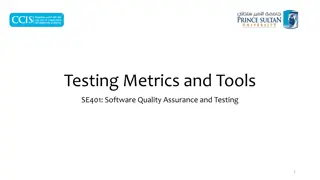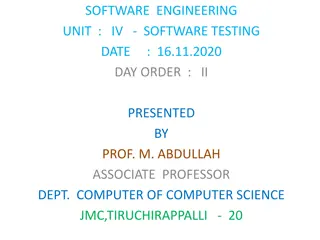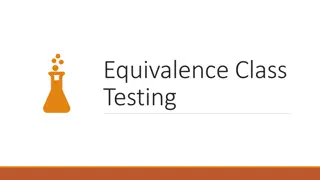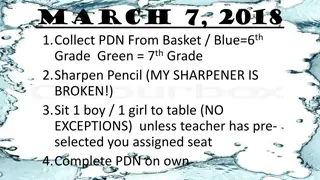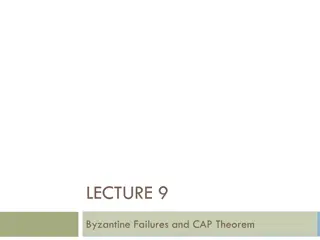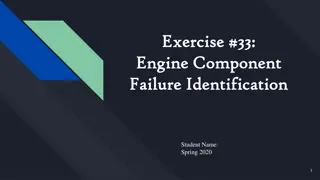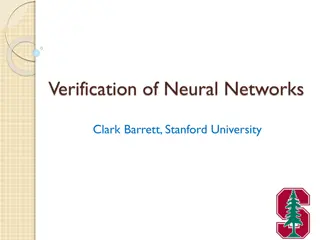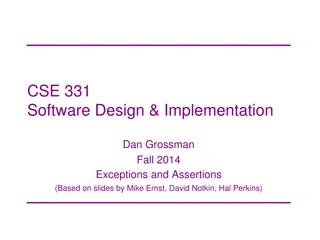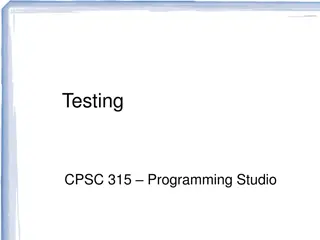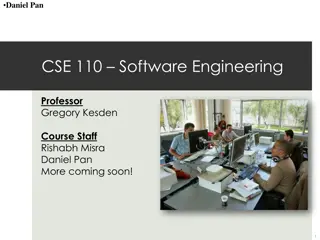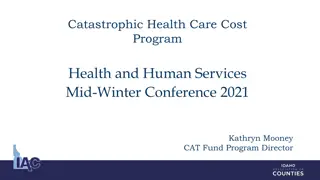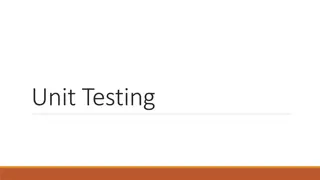Importance of Software Testing in Preventing Catastrophic Failures
Software testing is crucial in ensuring the reliability and safety of software systems, as highlighted by catastrophic failures such as the Ariane 5 rocket incident and the Therac-25 radiation therapy machine disasters. These examples underscore the importance of thorough testing in identifying and preventing critical bugs that can have severe consequences. Modern development ecosystems offer built-in support for testing, including unit testing frameworks like JUnit and regression testing frameworks. Testing principles, strategies, and real-world examples emphasize the need for robust testing practices in software development to avoid costly and potentially life-threatening failures.
Download Presentation

Please find below an Image/Link to download the presentation.
The content on the website is provided AS IS for your information and personal use only. It may not be sold, licensed, or shared on other websites without obtaining consent from the author. Download presentation by click this link. If you encounter any issues during the download, it is possible that the publisher has removed the file from their server.
E N D
Presentation Transcript
CSE 331 Software Design & Implementation Dan Grossman Fall 2014 Testing (Based on slides by Mike Ernst, David Notkin, Hal Perkins)
Outline Why correct software matters Motivates testing and more than testing, but now seems like a fine time for the discussion Testing principles and strategies Purpose of testing Kinds of testing Heuristics for good test suites Black-box testing Clear-box testing and coverage metrics Regression testing CSE331 Fall 2014 2
Non-outline Modern development ecosystems have much built-in support for testing Unit-testing frameworks like JUnit Regression-testing frameworks connected to builds and version control Continuous testing No tool details covered here See homework, section, internships, CSE331 Fall 2014 3
Ariane 5 rocket (1996) Rocket self-destructed 37 seconds after launch Cost: over $1 billion Reason: Undetected bug in control software Conversion from 64-bit floating point to 16-bit signed integer caused an exception The floating point number was larger than 32767 Efficiency considerations led to the disabling of the exception handler, so program crashed, so rocket crashed CSE331 Fall 2014 4
Therac-25 radiation therapy machine Excessive radiation killed patients (1985-87) New design removed hardware prevents the electron-beam from operating in its high-energy mode. Now safety checks done in software. Equipment control task did not properly synchronize with the operator interface task, so race conditions occurred if the operator changed the setup too quickly. Missed during testing because it took practice before operators worked quickly enough for the problem to occur. CSE331 Fall 2014 5
Mars Polar Lander Legs deployed Sensor signal falsely indicated that the craft had touched down (130 feet above the surface) Then the descent engines shut down prematurely Error later traced to a single bad line of software code Why didn t they blame the sensor? CSE331 Fall 2014 6
More examples Mariner I space probe (1962) Microsoft Zune New Year s Eve crash (2008) iPhone alarm (2011) Denver Airport baggage-handling system (1994) Air-Traffic Control System in LA Airport (2004) AT&T network outage (1990) Northeast blackout (2003) USS Yorktown Incapacitated (1997) Intel Pentium floating point divide (1993) Excel: 65,535 displays as 100,000 (2007) Prius brakes and engine stalling (2005) Soviet gas pipeline (1982) Study linking national debt to slow growth (2010) CSE331 Fall 2014 7
Costs to society as of 2002 Inadequate infrastructure for software testing costs the U.S. $22-$60 billion per year Testing accounts for about half of software development costs Program understanding and debugging account for up to 70% of time to ship a software product Improvements in software testing infrastructure might save 1/3 of the cost (Source: NIST Planning Report 02-3, 2002) CSE331 Fall 2014 8
Building Quality Software What Affects Software Quality? External Correctness Reliability Efficiency Integrity Does it do what it supposed to do? Does it do it accurately all the time? Does it do without excessive resources? Is it secure? Internal Portability Maintainability Flexibility Can I use it under different conditions? Can I fix it? Can I change it or extend it or reuse it? Quality Assurance (QA) Process of uncovering problems and improving software quality Testing is a major part of QA CSE331 Fall 2014 9
Software Quality Assurance (QA) Testing plus other activities including: Static analysis (assessing code without executing it) Correctness proofs (theorems about program properties) Code reviews (people reading each others code) Software process (methodology for code development) and many other ways to find problems and increase confidence No single activity or approach can guarantee software quality Beware of bugs in the above code; I have only proved it correct, not tried it. -Donald Knuth, 1977 CSE331 Fall 2014 10
What can you learn from testing? Program testing can be used to show the presence of bugs, but never to show their absence! Edsgar Dijkstra Notes on Structured Programming, 1970 Nevertheless testing is essential. Why? CSE331 Fall 2014 11
What Is Testing For? Validation = reasoning + testing Make sure module does what it is specified to do Uncover problems, increase confidence Two rules: 1. Do it early and often Catch bugs quickly, before they have a chance to hide Automate the process wherever feasible 2. Be systematic If you thrash about randomly, the bugs will hide in the corner until you're gone Understand what has been tested for and what has not Have a strategy! CSE331 Fall 2014 12
Kinds of testing Testing is so important the field has terminology for different kinds of tests Won t discuss all the kinds and terms Here are three orthogonal dimensions [so 8 varieties total]: Unit testing versus system/integration testing One module s functionality versus pieces fitting together Black-box testing versus clear-box testing Does implementation influence test creation? Do you look at the code when choosing test data? Specification testing versus implementation testing Test only behavior guaranteed by specification or other behavior expected for the implementation? CSE331 Fall 2014 13
Unit Testing A unit test focuses on one method, class, interface, or module Test a single unit in isolation from all others Typically done earlier in software life-cycle Integrate (and test the integration) after successful unit testing CSE331 Fall 2014 14
How is testing done? Write the test 1) Choose input data/configuration 2) Define the expected outcome Run the test 3) Run with input and record the outcome 4) Compare observed outcome to expected outcome CSE331 Fall 2014 15
sqrt example // throws: IllegalArgumentException if x<0 // returns: approximation to square root of x public double sqrt(double x){ } What are some values or ranges of x that might be worth probing? x < 0 (exception thrown) x 0 (returns normally) around x = 0 (boundary condition) perfect squares (sqrt(x) an integer), non-perfect squares x<sqrt(x) and x>sqrt(x) that's x<1 and x>1 (and x=1) Specific tests: say x = -1, 0, 0.5, 1, 4 CSE331 Fall 2014 16
Whats So Hard About Testing? Just try it and see if it works... // requires: 1 x,y,z 10000 // returns: computes some f(x,y,z) int proc1(int x, int y, int z){ } Exhaustive testing would require 1 trillion runs! Sounds totally impractical and this is a trivially small problem Key problem: choosing test suite Small enough to finish in a useful amount of time Large enough to provide a useful amount of validation CSE331 Fall 2014 17
Approach: Partition the Input Space Ideal test suite: Identify sets with same behavior Try one input from each set Two problems: 1. Notion of same behavior is subtle Naive approach: execution equivalence Better approach: revealing subdomains 2. Discovering the sets requires perfect knowledge If we had it, we wouldn t need to test Use heuristics to approximate cheaply CSE331 Fall 2014 18
Naive Approach: Execution Equivalence // returns: x < 0 => returns x // otherwise => returns x int abs(int x) { if (x < 0) return -x; else return x; } All x < 0 are execution equivalent: Program takes same sequence of steps for any x < 0 All x 0 are execution equivalent Suggests that {-3, 3}, for example, is a good test suite CSE331 Fall 2014 19
Execution Equivalence Can Be Wrong // returns: x < 0 => returns x // otherwise => returns x int abs(int x) { if (x < -2) return -x; else return x; } {-3, 3} does not reveal the error! Two possible executions: x < -2 and x >= -2 Three possible behaviors: x < -2 OK, x = -2 or x= -1 (BAD) x >= 0 OK CSE331 Fall 2014 20
Heuristic: Revealing Subdomains A subdomain is a subset of possible inputs A subdomain is revealing for error E if either: Every input in that subdomain triggers error E, or No input in that subdomain triggers error E Need test only one input from a given subdomain If subdomains cover the entire input space, we are guaranteed to detect the error if it is present The trick is to guess these revealing subdomains CSE331 Fall 2014 21
Example For buggy abs, what are revealing subdomains? Value tested on is a good (clear-box) hint // returns: x < 0 => returns x // otherwise => returns x int abs(int x) { if (x < -2) return -x; else return x; } {-2} {-1} {0} {1} { , -4, -3} {-2, -1} {0, 1, } Example sets of subdomains: Which is best? { ,-6, -5, -4} {-3, -2, -1} {0, 1, 2, } Why not: CSE331 Fall 2014 22
Heuristics for Designing Test Suites A good heuristic gives: Few subdomains errors in some class of errors E, High probability that some subdomain is revealing for E and triggers E Different heuristics target different classes of errors In practice, combine multiple heuristics Really a way to think about and communicate your test choices CSE331 Fall 2014 23
Black-Box Testing Heuristic: Explore alternate cases in the specification Procedure is a black box: interface visible, internals hidden Example // returns: a > b => returns a // a < b => returns b // a = b => returns a int max(int a, int b) { } 3 cases lead to 3 tests (4, 3) => 4 (i.e. any input in the subdomain a > b) (3, 4) => 4 (i.e. any input in the subdomain a < b) (3, 3) => 3 (i.e. any input in the subdomain a = b) CSE331 Fall 2014 24
Black Box Testing: Advantages Process is not influenced by component being tested Assumptions embodied in code not propagated to test data (Avoids group-think of making the same mistake) Robust with respect to changes in implementation Test data need not be changed when code is changed Allows for independent testers Testers need not be familiar with code Tests can be developed before the code CSE331 Fall 2014 25
More Complex Example Write tests based on cases in the specification // returns: the smallest i such // that a[i] == value // throws: Missing if value is not in a int find(int[] a, int value) throws Missing Two obvious tests: ( [4, 5, 6], 5 ) => 1 ( [4, 5, 6], 7 ) => throw Missing Have we captured all the cases? ( ( ) ) = = Must hunt for multiple cases Including scrutiny of effects and modifies CSE331 Fall 2014 26
Heuristic: Boundary Testing Create tests at the edges of subdomains Why? Off-by-one bugs Empty cases (0 elements, null, ) Overflow errors in arithmetic Object aliasing Small subdomains at the edges of the main subdomains have a high probability of revealing many common errors Also, you might have misdrawn the boundaries CSE331 Fall 2014 27
Boundary Testing To define the boundary, need a notion of adjacent inputs One approach: Identify basic operations on input points Two points are adjacent if one basic operation apart Point is on a boundary if either: There exists an adjacent point in a different subdomain Some basic operation cannot be applied to the point Example: list of integers Basic operations: create, append, remove Adjacent points: <[2,3],[2,3,3]>, <[2,3],[2]> Boundary point: [ ] (can t apply remove) CSE331 Fall 2014 28
Other Boundary Cases Arithmetic Smallest/largest values Zero Objects null Circular list Same object passed as multiple arguments (aliasing) CSE331 Fall 2014 29
Boundary Cases: Arithmetic Overflow // returns: |x| public int abs(int x) { } What are some values or ranges of x that might be worth probing? x < 0 (flips sign) or x 0 (returns unchanged) Around x = 0 (boundary condition) Specific tests: say x = -1, 0, 1 How about int x = Integer.MIN_VALUE; // x=-2147483648 System.out.println(x<0); // true System.out.println(Math.abs(x)<0); // also true! From Javadoc for Math.abs: Note that if the argument is equal to the value of Integer.MIN_VALUE, the most negative representable int value, the result is that same value, which is negative CSE331 Fall 2014 30
Boundary Cases: Duplicates & Aliases // modifies: src, dest // effects: removes all elements of src and // appends them in reverse order to // the end of dest <E> void appendList(List<E> src, List<E> dest) { while (src.size()>0) { E elt = src.remove(src.size()-1); dest.add(elt); } } What happens if src and dest refer to the same object? This is aliasing It s easy to forget! Watch out for shared references in inputs CSE331 Fall 2014 31
Heuristic: Clear (glass, white)-box testing Focus: features not described by specification Control-flow details Performance optimizations Alternate algorithms for different cases Common goal: Ensure test suite covers (executes) all of the program Measure quality of test suite with % coverage Assumption implicit in goal: If high coverage, then most mistakes discovered CSE331 Fall 2014 32
Glass-box Motivation There are some subdomains that black-box testing won't catch: boolean[] primeTable = new boolean[CACHE_SIZE]; boolean isPrime(int x) { if (x>CACHE_SIZE) { for (int i=2; i<x/2; i++) { if (x%i==0) return false; } return true; } else { return primeTable[x]; } } CSE331 Fall 2014 33
Glass Box Testing: [Dis]Advantages Finds an important class of boundaries Yields useful test cases Consider CACHE_SIZE in isPrime example Important tests CACHE_SIZE-1, CACHE_SIZE, CACHE_SIZE+1 If CACHE_SIZE is mutable, may need to test with different CACHE_SIZE values Disadvantage: Tests may have same bugs as implementation Buggy code tricks you into complacency once you look at it CSE331 Fall 2014 34
Code coverage: what is enough? int min(int a, int b) { int r = a; if (a <= b) { r = a; } return r; } Consider any test with a b (e.g., min(1,2)) Executes every instruction Misses the bug Statement coverage is not enough CSE331 Fall 2014 35
Code coverage: what is enough? int quadrant(int x, int y) { int ans; if(x >= 0) ans=1; else ans=2; if(y < 0) ans=4; return ans; } 2 1 3 4 Consider two-test suite: (2,-2) and (-2,2). Misses the bug. Branch coverage(all tests go both ways ) is not enough Here, path coverage is enough (there are 4 paths) CSE331 Fall 2014 36
Code coverage: what is enough? int num_pos(int[] a) { int ans = 0; for(int x : a) { if (x > 0) ans = 1; // should be ans += 1; } return ans; } Consider two-test suite: {0,0} and {1}. Misses the bug. Or consider one-test suite: {0,1,0}. Misses the bug. Branch coverage is not enough Here, path coverage is enough, but no bound on path-count CSE331 Fall 2014 37
Code coverage: what is enough? int sum_three(int a, int b, int c) { return a+b; } Path coverage is not enough Consider test suites where c is always 0 Typically a moot point since path coverage is unattainable for realistic programs But do not assume a tested path is correct Even though it is more likely correct than an untested path Another example: buggy abs method from earlier in lecture CSE331 Fall 2014 38
Varieties of coverage Various coverage metrics (there are more): Statement coverage Branch coverage Loop coverage Condition/Decision coverage Path coverage increasing number of test cases required (generally) Limitations of coverage: 1. 100% coverage is not always a reasonable target 100% may be unattainable (dead code) High cost to approach the limit 2. Coverage is just a heuristic We really want the revealing subdomains CSE331 Fall 2014 39
Pragmatics: Regression Testing Whenever you find a bug Store the input that elicited that bug, plus the correct output Add these to the test suite Verify that the test suite fails Fix the bug Verify the fix Ensures that your fix solves the problem Don t add a test that succeeded to begin with! Helps to populate test suite with good tests Protects against reversions that reintroduce bug It happened at least once, and it might happen again CSE331 Fall 2014 40
Rules of Testing First rule of testing: Do it early and do it often Best to catch bugs soon, before they have a chance to hide Automate the process if you can Regression testing will save time Second rule of testing: Be systematic If you randomly thrash, bugs will hide in the corner until later Writing tests is a good way to understand the spec Think about revealing domains and boundary cases If the spec is confusing, write more tests Spec can be buggy too Incorrect, incomplete, ambiguous, missing corner cases When you find a bug, write a test for it first and then fix it CSE331 Fall 2014 41
Closing thoughts on testing Testing matters You need to convince others that the module works Catch problems earlier Bugs become obscure beyond the unit they occur in Don't confuse volume with quality of test data Can lose relevant cases in mass of irrelevant ones Look for revealing subdomains Choose test data to cover: Specification (black box testing) Code (glass box testing) Testing can't generally prove absence of bugs But it can increase quality and confidence CSE331 Fall 2014 42
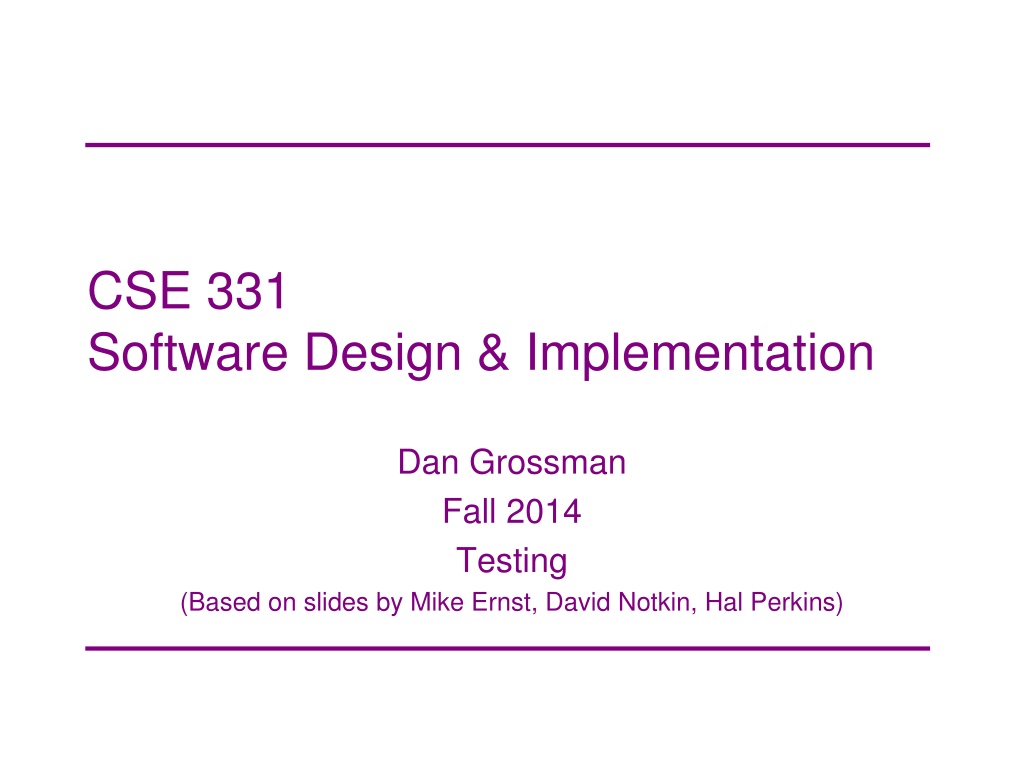
 undefined
undefined



